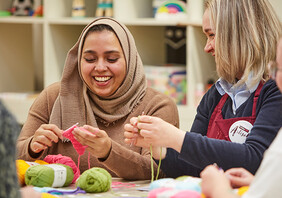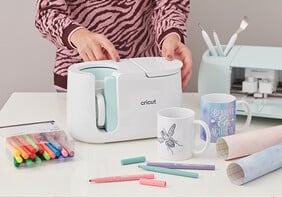How to Make Faux Wabi-Sabi Vases
Have you heard of the concept of 'wabi-sabi'? Based on Japanese aesthetics, put very simply it is the art of transience and imperfection; the joy of the perfectly imperfect. The concept embraces frayed edges, mottled finishes, scratches and breakages – essentially those 'imperfect' marks left by the passing the time.
An extension of the wabi-sabi philosophy is Kintsugi – 'golden joinery'. This is the Japanese art of repairing broken pottery with lacquer mixed with powdered gold, silver, or platinum. Kintsugi treats breakage and repair as part of the history of an object, rather than something to hide. This repair process is incredibly beautiful and looks very effective as a design in itself.
We couldn't resist giving our Hobbycraft plain ceramics the Kintsugi treatment. Don't worry we didn't break the pots! We simply gave them a mottled, perfectly imperfect colouring by dabbing a rough sponge over POSCA pens for our base colour. We then created our own imaginary 'cracks' with a gold POSCA marker.
Water-based and non-toxic POSCA pens work on a range of surfaces including ceramics, glass and wood so you could potentially create a whole host of Kintsugi inspired crafts with your POSCA paint markers.
You will need
How to make
Get your POSCA started by shaking your pen and pressing down on scrap paper to get the consistent paint flow to your pen nib. Now, colour in an area of your chosen ceramic vase with heavy, wet layers of blue POSCA paint pen.

While the POSCA paint is still wet, dab with a damp sponge to cover the vase, creating a mottled effect. You can leave areas plain white for contrast or cover the entire vase, it's up to you.

You should have a loose, almost marble-style covering.

To make the colour more intense, layer with fresh POSCA pen and while the paint is still wet, dab with a dry sponge.
For the green/blue design, simply blend layers of green and blue POSCA pen and repeat steps one to four. When you are happy with the colour coverage of your vases, leave to dry.

Once the vases are dry you can apply your gold Kintsugi-style design with the gold POSCA marker. Here we've started with a jagged line to mark the 'break'. Keep a good creamy paint flow by shaking your pen (lid on) and pressing the nib down on a scrap bit of paper so you ensure the right paint consistency. Repeat this as often as necessary.

From that line you can draw further 'cracks'. Don't be afraid to let your POSCA pen run a little, it all adds to the effect.

When you are happy with your designs, place in the oven at 160-degrees (gas mark 2) for 45 minutes to make permanent.







